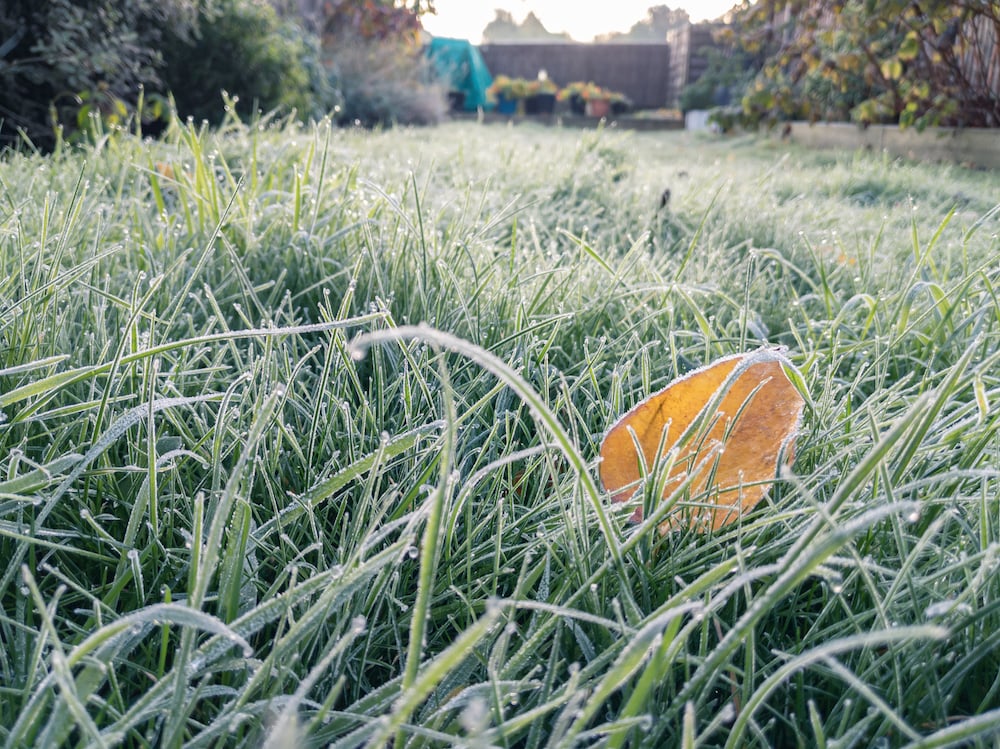Avoiding lawn frost damage and maintaining a healthy yard can be challenging during winter. As always, spotting the warning signs will be key to a successful return to mowing and gardening in the Spring.
It might make for a pretty photo, but frozen grass can cause significant damage, and it’s important to understand what can be done to protect your lawn.
So, let’s explore some of the key maintenance areas during the colder months and what to watch out for when planning your lawn care.
Frost vs Hard Freeze: What a Normal Dormant Stage of the Lawn Looks Like
Frost is something that occurs on clear, cold nights when the air becomes warmer than the grass and the ground temperature is colder than the surrounding air.
Frost will begin to form on a surface that is at freezing, a process that usually begins when the ground temperature falls below 32 degrees. The main thing to note is that a light frost will still allow the grass to grow as the ground remains unfrozen.
When the temperature dips further and the ground freezes, this is when a hard frost sets in, and winter dormancy begins in plants.
A hard freeze occurs when the temperature drops to 28 degrees or lower for a prolonged period. This can lead to a major killing off of plants and crops, especially for those items that cannot be covered.
The normal dormancy stage happens during the winter and is triggered by cold temperatures. This is how your lawn can naturally protect itself by channeling its limited resources to the crown and roots, leaving the rest to go brown.
So while a dormant lawn will be brown in the leaves, the important crowns and stalk should remain healthy, along with the roots. The best way to check for a dead lawn is to determine whether that brown and brittle nature has spread from the leaves to the roots.
What are the Signs of Frost Damage?
As mentioned above, you must inspect your lawn closely to look for frost damage and how it might have affected your yard. You can start by looking closely at the leaf blades and check for that burned and discolored effect, from the leaf tip, down about an inch.
However, if the emerging leaf tissue looks healthy, this means that the affected top layer has taken the brunt of the frost damage, and you won’t be dealing with dead grass come your first Spring mow.
Lawn Damage To Watch Out For and How To Prepare For Spring
Ice becomes microscopic daggers to grass, and normal everyday activities can affect your lawn. Simply walking on grass can cause issues, as those daggers will impact your grass blades on a cellular level. You should also note how long your lawn has been exposed to freezing temperatures, as it will take longer to recover following extended exposure to these elements.
To give your lawn the best chance of surviving through the winter unscathed, a late fall fertilizer application makes for an excellent winterization tool. Replenishing the soil with nutrients improves its root system before damaging weather can set in, providing an improved defense against winter injury.
Ensuring you take care not to overfeed your lawn in late fall is essential, as this can cause salt build-up, leaving your soil to dry out and making it vulnerable during the colder months of dryness.
Let Lush Lawn Help With Your Post-Winter Needs
We can help get your lawn back in shape after a bad winter frost, and we have services and multiple treatments so that your lawn bounces back. Remember, not all lawn diseases flourish in warm weather. Some progress under the extremely low temperatures in Michigan. To get a free estimate for your yard, contact Lush Lawn today.
